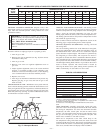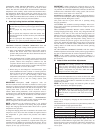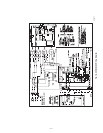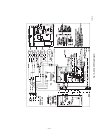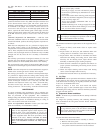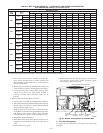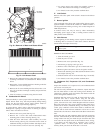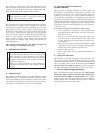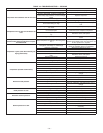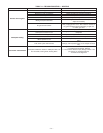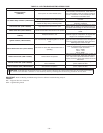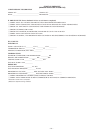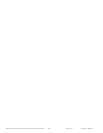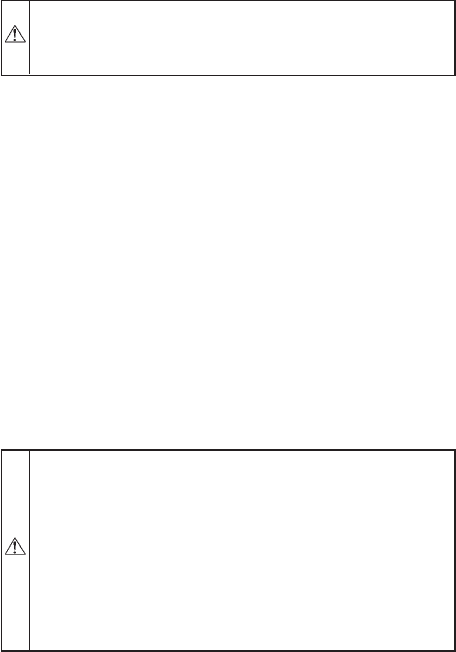
The compressor is an electrical (as well as mechanical) device.
Exercise extreme caution when working near compressors. Power
should be shut off, if possible, for most troubleshooting tech-
niques. Refrigerants present additional safety hazards.
WARNING: Wear safety glasses and gloves when han-
dling refrigerants. Failure to follow this warning can
cause a fire, serious injury, or death.
The scroll compressor pumps refrigerant throughout the system by
the interaction of a stationary and an orbiting scroll. The scroll
compressor has no dynamic suction or discharge valves, and it is
more tolerant of stresses caused by debris, liquid slugging, and
flooded starts. The compressor is equipped with an anti-rotational
device and an internal pressure relief port. The anti-rotational
device prevents the scroll from turning backwards and replaces the
need for a cycle protector. The pressure relief port is a safety
device, designed to protect against extreme high pressure. the
relief port has an operating range between 550 and 625 psi
differential pressure.
The Copeland scroll compressor uses Mobil 3MA POE oil.
This is the only oil allowed for oil recharge.
P. REFRIGERANT SYSTEM
CAUTION: This system uses Puron (R-410A) refriger-
ant which has higher operating pressures than R-22 and
other refrigerants. No other refrigerant may be used in
this system. Gage set, hoses, and recovery system must be
designed to handle Puron. If you are unsure consult the
equipment manufacturer.
Failure to use Puron compatible servicing equipment or
replacement components may result in property damage
or injury.
Q. Compressor Oil
The compressor in this system uses a polyolester (POE) oil, Mobil
3MA POE. This oil is extremely hygroscopic, meaning it absorbs
water readily. POE oils can absorb 15 times as much water as other
oils designed for HCFC and CFC refrigerants. Take all necessary
precautions to avoid exposure of the oil to the atmosphere.
R. Servicing Systems on Roofs with
Synthetic Materials
POE (polyolester) compressor lubricants are known to cause long
term damage to some synthetic roofing materials. Exposure, even
if immediately cleaned up, may cause embrittlement (leading to
cracking) to occur in one year or more. When performing any
service that may risk exposure of compressor oil to the roof, take
appropriate precautions to protect roofing. Procedures which risk
oil leakage include, but are not limited to, compressor replacement,
repairing refrigerant leaks, replacing refrigerant components such
as filter drier, pressure switch, metering device, coil, accumulator,
or reversing valve.
SYNTHETIC ROOF PRECAUTIONARY PROCEDURE:
1. Cover extended roof working area with an impermeable
polyethylene (plastic) drip cloth or tarp. Cover an approxi-
mate 10 x 10 ft. area.
2. Cover area in front of the unit service panel with a terry
cloth shop towel to absorb lubricant spills and prevent
run-offs, and protect drop cloth from tears caused by tools
or components.
3. Place terry cloth shop towel inside unit immediately under
component(s) to be serviced and prevent lubricant run-offs
through the louvered openings in the base pan.
4. Perform required service.
5. Remove and dispose of any oil contaminated material per
local codes.
S. Liquid Line Filter Drier
The filter drier is specifically designed to operate with Puron. Use
only factory-authorized components. Filter drier must be replaced
whenever the refrigerant system is opened. When removing a filter
drier, use a tubing cutter to cut the drier from the system. Do not
unsweat a filter drier from the system. Heat from unsweating
will release moisture and contaminants from drier into system.
T. Puron (R-410A) Refrigerant Charging
Refer to unit information plate and charging chart. Some R-410A
refrigerant cylinders contain a dip tube to allow liquid refrig-
erant to flow from cylinder in upright position. For cylinders
equipped with a dip tube, charge Puron units with cylinder in
upright position and a commercial metering device in manifold
hose. Charge refrigerant into suction-line.
—24—



